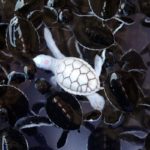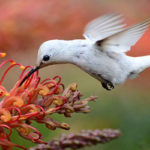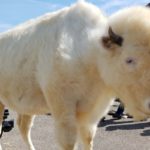Rarest Albino Animals In The World
1 Albino Alligator
This albino alligator actually resides at the California Academy of Sciences, where he has lived for the past 10 years. The alligator, named Claude, would struggle to survive in the wild on his own. One product of his albinism is poor eyesight, so he often bumps into things and would be unable to protect himself.

Despite living in captivity, the staff at the California Academy of Sciences try to give Claude a good life. On his 15th birthday, the staff threw him a big party. Claude likely still has many birthdays left, as he could live to be 80 years old.
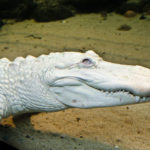
2 Albino Tiger

White tigers are their own species of animal that are actually born with a genetic mutation that turns their fur white. However, white tigers still have black stripes along their fur. Albino tigers, on the other hand, are white as snow across their whole bodies.

Rather than the orange and black stripes found on typical tigers, albino tigers look as pure and clean as polar bears. The image of an all-white tiger is certainly striking, especially next to one of his more typical-looking counterparts.

3 Albino Snake
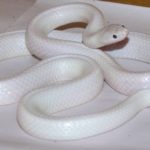
Any animal can be afflicted by albinism, including snakes. This salty gray snake, a native species of Australia, is usually brown. However, it looks particularly striking with its all-white body.
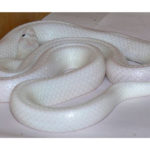
When this snake was found, it was placed under the protection of the Territory Wildlife Park in the Northern Territory of Australia. After being cared for and quarantined to rid the snake of any harmful germs, the park put the snake on display so the rest of the world could marvel at its snowy-white beauty.
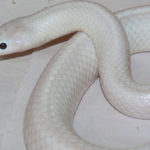
4 Albino Bat
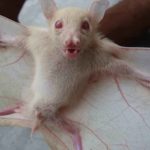
Bats are known for being jet black. As nocturnal animals, their dark wings and fur help them blend in during the night. But not all bats inherit the typical camouflage-friendly outward appearance.
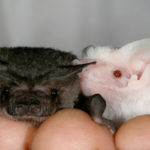
Bats, just like many other animals, can be affected by albinism. As usual, the disorder turns the bat’s wings and fur from black to white. There will be no flying around unseen for this albino bat.
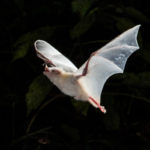
5 Albino Penguin

Like many animals, a penguin’s appearance plays a very specific role in the animal’s survival. Most penguins are black and white, which allows them to blend in while underwater. This natural camouflage ability allows the animal to safely escape predators.

Unfortunately, an albino animal who lacks this natural camouflage may struggle to survive in the wild. Not only does an albino penguin stand out amongst its peers, but it’s also easy to spot in the water, leaving it open for an attack.
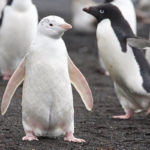
6 Albino Raccoon

Raccoons are best known for the circular tufts of black fur around their eyes that create a sort of mask. Beyond that, raccoons are usually a grey-ish brown color, with small patches of white across their bodies. Their dark colors help them to sneak around at night, which perfectly fits their nocturnal habits.
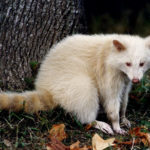
But there’s one raccoon who may struggle to travel during the night unseen. The albino raccoon is completely white and devoid of any of the typical markings found on this species. The bright white color means anyone will be able to spot this trash panda lurking around their home.
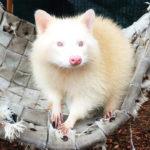
7 Albino Zebra
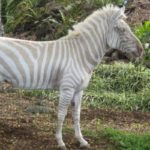
Zebras are known for their black and white bodies, but albino zebras look completely different. However, an albino zebra isn’t completely white. The animal still has stripes, just of a different color.
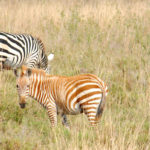
The albino zebra is mostly white with golden stripes running across its body. However, the albino zebra may not lose much by losing its stripes. While scientists have theories about the color of a zebras body, they can’t be 100% sure about the purpose the stripes serve.
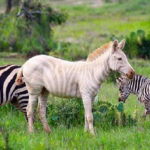
8 Albino Turtle
This turtle is especially stunning, as he appears in a sea of his much-darker fellow aquatic animals. While the turtle’s shell is still defined by dark lines, the rest of his body and shell are pure white.
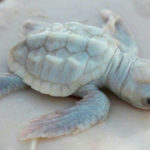
There would be no trouble spotting this turtle swimming in the ocean. Thankfully, his different appearance doesn’t seem to affect the rest of his group. While he may have a difficult time surviving with his condition, hopefully the support of his nest will help him to thrive.
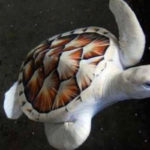
9 White Lion

White lions are actually much more common than other types of albino animals. In fact, white lions don’t even suffer from albinism. Instead of lacking pigmentation like albino animals, white lions have a gene that naturally produces a lighter pigmentation for their fur.

Despite the technical differences, the final look of the white lion is still stunning. These lions are so strikingly beautiful in the wild that they’re even revered as scared by some African tribes. However, they are also struggling with extinction from hunters in the area.

10 Albino Reindeer
While reindeers are best known for their reputation of pulling Santa’s sleigh, they’re actually quite prominent in the wild. However, reindeers are often a dark brown color with spots of white across their bodies. That is, unless you’re talking about an albino reindeer.
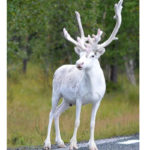
In the picture above, you can see a normal reindeer to the left. However, the most eye-catching part of the image, of course, is the albino reindeer striking a pose in the center. With a completely white body, the reindeer will certainly have trouble hiding from predators. But despite the survival difficulties, there’s no denying the albino reindeer is stunning.
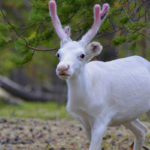
11 Albino Moose
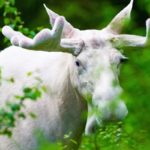
With its large stature and huge antlers, a moose is always an imposing presence. But when the animal is completely white, it’s all the more stunning.
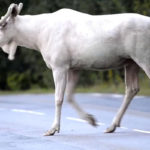
Found in the wilderness of Sweden, the locals named this moose Ishmael. Despite its white appearance, experts have stated that the moose isn’t fully albino, as it’s missing the red eyes that are a signature feature of albinism. Still, the moose is quite an incredible sight, and similar animals have been spotted in other locations around the world, including Canada and Alaska.
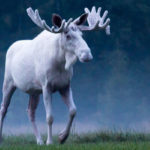
12 Albino Whale

Some people will go their whole lives without ever spotting a normal whale, so just think of how rare it must be to see an albino whale. While you may never see one in person, these magnificent creatures do reside in the ocean.
Some lucky onlookers have spotted albino whales off the coast of Norway and Australia. Oftentimes, the whales will travel great distances in search of plankton. The yellow spotting on the whale’s skin is a direct result of the plankton they’re eating. The healthier the plankton, the whiter the whale’s skin will be.

13 Albino Hummingbird

Hummingbirds are generally a gorgeous mix of greens, reds, teals, and other stunning colors, depending on the species of bird. Considering color is what you expect when you see a hummingbird, the albino hummingbird is especially eye catching.
All-white with pink-ish feet, bills, and eyes, this hummingbird is certainly rare. In fact, only one in 1,764 birds born will be an albino hummingbird. If you happen to see one, take some time to appreciate its beauty, as you’ll probably never come across one again.
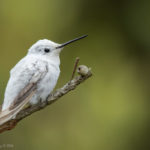
14 Albino Squirrel
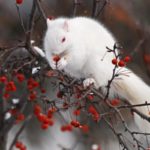
Squirrels aren’t exactly known for their beauty. In fact, they’re often considered rather mangy. But there’s something about all-white fur that adds a bit of beauty to this small rodent.
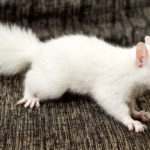
Unlike normal squirrels that blend more effectively into their surroundings with their brown fur, albino squirrels stick out. The snowy fur makes them look somewhat inviting, though they’re no different (beyond their fur) from their other scampering peers.
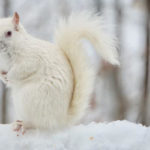
15 Albino Kangaroo

While kangaroos aren’t common in other parts of the world, they can be found all over Australia. But even though kangaroo sightings are common across the country, spotting an albino kangaroo is still incredibly rare.
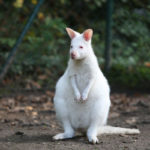
With the typical white hair and red eyes, albino kangaroos almost look like an entirely different animal. Unfortunately, they also struggle with vision and hearing problems, which makes it difficult for these animals to survive in the wild.
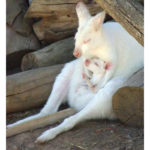
16 Albino Peacock
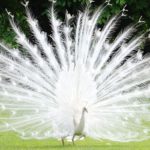
Peacocks are known for their colorful appearances. Male peacocks feature feathers in a range of vibrant hues, including blue, turquoise, and green. But what does a peacock look like when all that color is taken away?
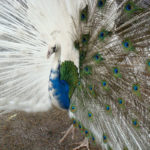
As it turns out, an albino peacock is just as stunning as its colored counterparts. In fact, the albino bird may be even more eye-catching, as his appearance is entirely unexpected. With his all-white feathers branching out from his body, this peacock can’t help but look somewhat angelic.
17 Albino Kookaburra
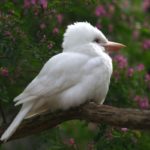
Kookaburras are a type of bird native to Australia. Normally, kookaburras are brown in color, with a lighter stomach and dark feathers on their back. However, this kookaburra is missing the typical colors of the animal.
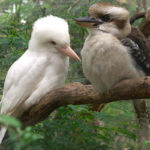
Rather than brown feathers, the albino kookaburra is a snowy white. However, the beautiful appearance of the albino kookaburra doesn’t take away from this bird’s fierce persona. To survive in Australia, kookaburras can eat snakes up to three feet long, and the albino kookaburra is no different.
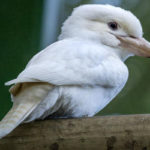
18 Albino Gorilla

While sometimes beautiful in appearance, albinism isn’t an easy disorder to live with. It can cause several problems in humans and animals, some of which are life threatening. In the case of this albino gorilla, his struggle with albinism doesn’t have a happy ending.
Snowflake, the albino gorilla pictured above, used to reside in the Barcelona Zoo in Spain. In 2003, he was diagnosed with a rare form of skin cancer. Though the exact reason was unknown, it was assumed the skin cancer developed from Snowflake’s albinism. He was euthanized to prevent any suffering, but still lives on in memory as the world’s only white gorilla.

19 Pinky The Albino Dolphin

While albinism often turns animals pure white, that’s not the case every time. Pinky is a dolphin who suffers from albinism. But in Pinky’s case, her condition turned her skin a light pink color.

Pinky resides in Lake Calcasieu in Louisiana. Since Pinky’s cells don’t make the melanin pigment that gives most dolphins their gray color, the underlying color of Pinky’s blood cells shows through her skin. The result is her shocking, but beautiful, pink appearance.

20 Onya-Birri The Albino Koala

The staff at the San Diego Zoo got quite the surprise in 1997 when this albino koala was born from two gray koalas. Albino koalas are extremely rare, though they have occasionally appeared in the wild before. To have one born in captivity, however, was especially surprising.

The fuzzy baby was immediately named Onya-Birri, which means ghost boy in indigenous Australian. The zoo staff didn’t even realize Onya-Birri was so unique for quite a while, as he spent the first six months of his life in his mother’s pouch.
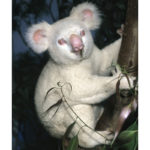
21 Albino Ferret

Normal ferrets are generally a mixture of brown and white. While their backs and the fur around their eyes are white, the rest of the body is a dark brown, almost black color. Of course, that isn’t the case for albino ferrets, who have a snow-white appearance from head to toe.
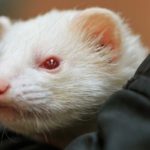
Unfortunately, albino ferrets come with their own set of struggles. A ferret’s vision isn’t perfect normally, and an albino ferret, in particular, really struggles to see. Ferrets see best in low light, so albino ferrets will have a hard time making out their surroundings in the harsh light of the day.

22 Albino Buffalo
Normally, buffalos are black, sometimes with brown or white patches. They can also look dark brown in appearance, depending on where the buffalo are from. But considering their normally dark colors, the albino buffalo is especially eye catching.
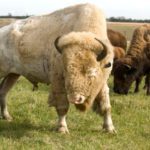
Lots of albino buffalo can be found in North Dakota, and are often protected by the National Buffalo Museum located there. One buffalo was born in 1996 and even gave birth to a rare white bison throughout her lifetime. Because of the work of this museum, albino buffalos are actually much more common than other albino animals.

23 Albino Snail

Albino snails are incredibly rare. In fact, only two have ever been recorded. The second was found in New Zealand in 2011. Scarily enough, that snail was also quite large and carnivorous.

While darker-colored snails are able to hide and escape predators, albino snails can be spotted easily. Therefore, albino snails don’t often last long in the wild. That’s probably part of the reason why only two albino snails have ever been officially recorded.

24 Albino Lobster
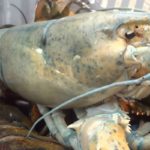
A few lucky lobster fishermen have had the pleasure of coming across an albino lobster in their time. The latest albino lobster was spotted this very year in Boston, where a fishery noticed the bright spot of white amongst the other red lobsters.
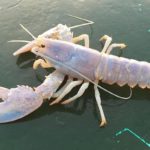
Apparently, only one in 100 million lobsters are albino. Another albino lobster was caught by fishermen in Maine all the way back in 2014. Of course, these lobsters were actually lucky because of their albino appearance. While it might make it harder for them to survive in the wild, it saved them from being cooked once caught, unlike their other unlucky lobster peers.

25 Albino Blackbird
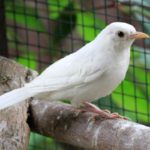
Blackbirds are literally named after their signature color. However, not all blackbirds are black. Some blackbirds actually sport a bright white appearance, in direct contrast to their nomenclature.
Once again, while being a white blackbird is beautiful, it’s not actually practical for survival. Blackbirds are small, so their color helps them to blend in with their surroundings and avoid predators. With an all-white appearance, albino blackbirds are easy prey, which means they don’t survive long in the wild.
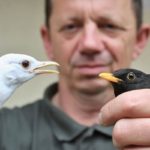
26 Albino Monkey
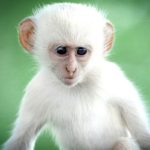
When people think of monkeys, brown is most likely the color that comes to their mind. But, as you can see, albino monkeys do exist, and they’re quite adorable. This monkey was first spotted as a baby in Livingstone, Zambia.

With their all-white appearance, albino monkeys look quite different from their peers. This Zambia-based monkey acted fairly normal, but it did seem to spend a lot of time alone. Still, the monkey seemed happy to climb trees, play, and jump around, so it’s possible that it’s just his appearance that confuses the monkeys around him and leads to his more isolated life.

27 Albino Donkey
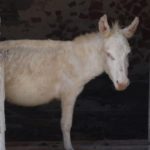
Albino donkeys are actually quite common. At least, they are on the island of Asinara, where a herd of about 120 donkeys all live together. Asinara is located off the coast of Sardinia, Italy. For some strange reason, it’s also the home of this large band of albino donkeys.
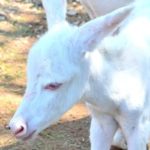
These donkeys have officially been named Asinara donkeys, after their homeland. The entire herd is believed to carry the albino gene. While the donkeys are feral, the island itself is a popular tourist attraction. While you don’t want to get too close to these animals, just seeing them in person would be worth the trip.
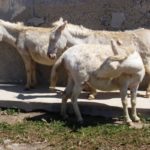
28 Albino Skunk
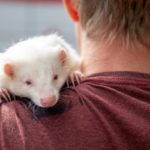
Skunks are known for their black and white appearance. If you’re looking out for a skunk, their signature white stripes against black fur would be the first tell. How confusing, then, to learn that albino skunks do exist.
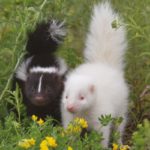
If you saw one of these skunks hanging out around your home, you might mistake them for a dog or a cat. That mistake could be disastrous, however, if you get too close and the skunk decides to spray you. These skunks have particularly been spotted in the Canadian province of Prince Edward Island. Park rangers and other professionals in that region claim they’ve never heard of an albino skunk before seeing one for themselves.

29 Albino Giraffe

While giraffes can be seen in zoos around the world, they originally come from Southern and Eastern Africa. However, giraffes are now vulnerable to extinction for a variety of reasons, including illegal hunting and climate change.

Because the population of giraffes is decreasing, the chances of spotting a white giraffe are next to none. However, a few have been captured throughout the years. Rather than the typical brown, spotted appearance, albino giraffes are mostly white, with a few areas of their body covered in normal colors.

30 Albino Porcupine
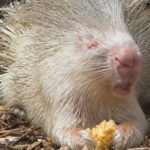
Porcupines, known for the dangerous quills all over their body, are usually brown. However, in 2019, an all-white creature was spotted in Portland, Maine. After some investigation, experts concluded that the animal was a baby albino porcupine.

Only one in about 10,000 porcupines is albino. The sighting was certainly shocking to onlookers and is one of the only sightings of an albino porcupine on record. While porcupines are quite dangerous, it’s hard to imagine that this fluffy-looking white creature could be all that scary.


